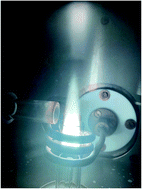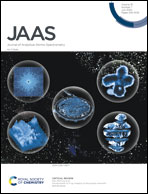How much aqueous sample can an inductively coupled plasma withstand?†
Abstract
During this study, a compact infrared-heated sample introduction system at 200 °C or 280 °C, consisting of a modified cyclonic spray chamber with a ceramic rod heater within a baffle at its centre and a ceramic rope heater wrapped around the base of the torch, was operated at sample uptake rates of 100, 150, 200, 250 and 300 μL min−1 in ICP optical emission spectrometry. The plasma never extinguished although it flickered at 200 and 250 μL min−1. At 280 °C, no drainage occurred up to 250 μL min−1, indicating total consumption. This is more than double the highest sample uptake rate previously used for total sample introduction. Sensitivity was similar or improved compared to that obtained with a baffled cyclonic spray chamber at room temperature but operating at 1 mL min−1. Plasma robustness, assessed using the Mg II 280.270/Mg I 285.213 nm signal ratio, of at least 8 was achieved at 100 and 150 μL min−1, at 200 °C, and at 100 μL min−1, at 280 °C, but degraded to 7 and 3 at 250 μL min−1, at 200 °C and 280 °C, respectively. The detection limit for all sample uptake rates at 280 °C was better than that obtained at 200 °C and than that with a baffled cyclonic spray chamber at room temperature. Although the precision at 280 °C was better than that obtained at 200 °C, it was generally degraded because a single set of ICP operating conditions, established with the reference system, was used in all cases. Hence, re-optimization of ICP operating conditions should enable total sample consumption at up to 250 μL min−1 with improved sensitivity as well as similar or improved detection limits, precision and plasma robustness.

- This article is part of the themed collection: Winter Conference on Plasma Spectrochemistry, USA


 Please wait while we load your content...
Please wait while we load your content...